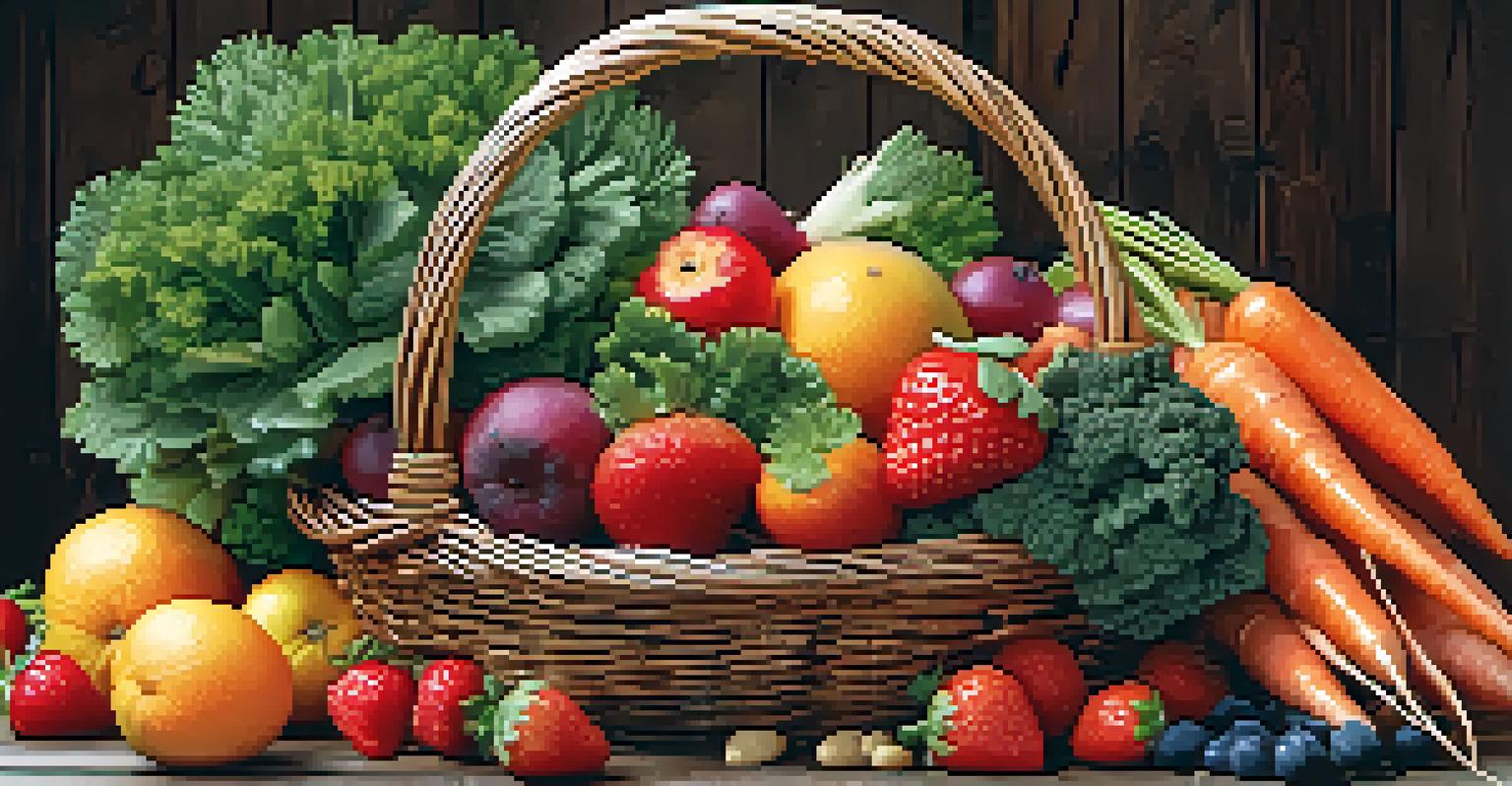Local Produce: The Heart of Community Supported Agriculture

Understanding Community Supported Agriculture (CSA)
Community Supported Agriculture, commonly known as CSA, is a model that connects consumers directly with local farmers. This relationship allows people to purchase a share of the farm's harvest, which means receiving fresh produce throughout the growing season. It's like having a mini-market right in your backyard, fostering a sense of community and supporting local economies.
The future of food is not just about sustainability, it's about building a community around food.
In a CSA, members typically pay upfront for a share, which helps farmers with their operating costs. This innovative approach not only ensures that farmers have a guaranteed market for their goods but also provides consumers with fresh, seasonal produce. It’s a win-win situation where everyone benefits from a direct connection to the food they eat.
By joining a CSA, members often discover new fruits and vegetables, expanding their culinary horizons. Plus, they get to know the farmers who grow their food, creating a personal investment in their local agriculture. This sense of belonging and community makes CSA an attractive option for many.
The Benefits of Local Produce for Health
Eating local produce has numerous health benefits, starting with freshness. When fruits and vegetables are harvested and consumed shortly after, they retain more nutrients compared to those that have traveled long distances. This means that your body is getting the maximum health benefits from the food you eat.

Moreover, local produce is often grown without the extensive use of preservatives and chemicals that are commonly found in mass-produced items. This connection to local farming practices can lead to cleaner, healthier options that are better for your body and the environment. Think of it as choosing to fuel your body with quality ingredients, just like you would with a high-performance vehicle.
Support Local Farmers with CSA
Joining a Community Supported Agriculture (CSA) program directly supports local farmers, ensuring they have a stable income while providing fresh produce to the community.
In addition, consuming seasonal produce encourages a diverse diet that changes with the seasons. This variety not only keeps meals exciting but also ensures a broader range of nutrients, which is essential for overall health. It’s like nature’s way of reminding us to enjoy the flavors of each season.
Supporting Local Farmers and the Economy
By participating in a CSA, you directly support local farmers and their families. This financial backing helps sustain small farms, which are often the backbone of rural communities. When you buy local, your money stays in the community, fostering economic growth and job creation.
Eating locally is not a trend; it’s a return to the roots of our food systems, supporting our farmers and our communities.
Local farmers typically have a smaller carbon footprint compared to large-scale agricultural operations. They often use more sustainable practices, and buying from them helps to promote this environmentally-friendly approach. It’s akin to voting with your wallet, choosing to support practices that align with your values.
Additionally, many local farms participate in community initiatives, such as educational programs and workshops. This further strengthens community ties and fosters a culture of sustainability. When you invest in local agriculture, you’re not just purchasing food; you’re nurturing the community's future.
Environmental Impact of Local Farming
Local farming practices can significantly reduce environmental impact, particularly in transportation emissions. When you buy local produce, you’re lessening the distance food travels to reach your plate, which means fewer carbon emissions. It’s a simple yet effective way to contribute to a healthier planet.
Moreover, many local farms prioritize sustainable farming methods, such as crop rotation and organic practices. These approaches help maintain soil health, protect water resources, and promote biodiversity. It’s like restoring balance to an ecosystem, ensuring that farming can coexist harmoniously with nature.
Health Benefits of Local Produce
Eating local produce not only guarantees freshness and higher nutrient retention but also promotes a cleaner diet free from excessive preservatives.
Choosing local also encourages the preservation of open land and green spaces, which are essential for wildlife and community wellbeing. By supporting local farmers, you’re participating in a larger movement to protect the environment for future generations. Every purchase is a step toward a more sustainable future.
Building Community Connections Through CSA
CSAs are not just about food; they’re about building relationships within the community. Through shared experiences, members often form bonds with each other and with the farmers. This sense of connection transforms how we view food, shifting from mere consumption to a shared journey.
Many CSAs host events, such as farm tours and potlucks, where members can gather, share recipes, and celebrate the harvest together. These gatherings foster a sense of belonging and community spirit that is often missing in our modern, fast-paced lives. It’s like stepping back in time to when neighbors knew one another and came together to support local initiatives.
Engaging with a CSA creates a network of support for local agriculture and encourages other community members to get involved. It’s a ripple effect; one person’s commitment to local produce can inspire others to join the movement. Together, communities can thrive and create a sustainable food system.
How to Choose the Right CSA for You
Choosing the right CSA can seem daunting at first, but it doesn’t have to be. Start by researching local farms and their offerings; many farms provide detailed information about their growing practices and share what types of produce are in season. This way, you can align your values with the CSA that best fits your lifestyle.
Consider what you want from a CSA. Do you prefer a traditional box of assorted produce, or do you want to have the option to customize your order? Some CSAs even offer add-ons like eggs, dairy, or flowers. It’s all about finding a fit that will keep you excited about your weekly share.
Build Community Connections
CSAs foster community relationships through shared experiences, transforming food consumption into a collaborative journey among members and farmers.
Lastly, don’t hesitate to reach out to the farms directly with questions. Many farmers are eager to share their stories, growing methods, and what makes their CSA unique. This engagement not only helps you make an informed decision but also strengthens the connection between you and your local agricultural community.
The Future of Local Produce and CSA
As consumers continue to seek fresh, healthy, and sustainably-sourced food, the future of local produce and CSAs looks promising. More people are becoming aware of the benefits of supporting local agriculture, leading to a resurgence in community-supported models. This shift reflects a broader trend toward sustainability and conscious consumerism.
Innovative technologies are also playing a role in the evolution of CSAs. From online platforms that simplify ordering to apps that connect consumers with local farms, the possibilities are expanding. This integration of technology allows for greater accessibility, making it easier for people to engage with local produce.

The growing interest in urban farming is another exciting development, bridging the gap between city dwellers and local agriculture. As more urban areas embrace farming initiatives, the connection to local produce will only strengthen. The future is bright for community-supported agriculture, and with it, our communities will thrive.